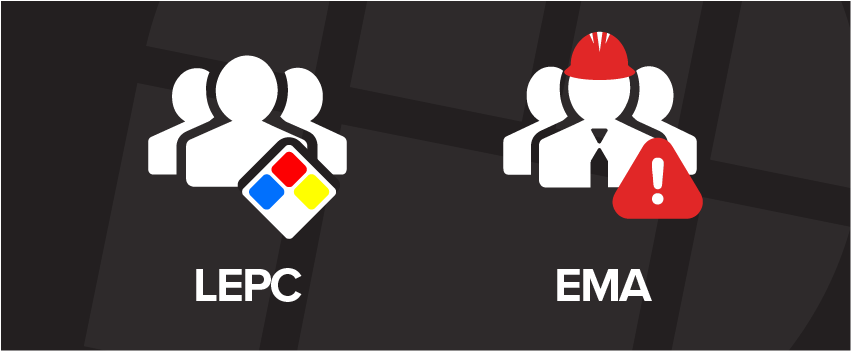Expert Guidance on HAZMAT Planning
Being prepared for a hazardous materials emergency is critical for a successful response that maintains the safety of your employees, the first responders and the facility itself. Through this interview with Rodger Norcross, former fire chief and law enforcement officer, you’ll gain insight into how to properly plan for hazard mitigation.

Question: Can you provide some details on your professional background as it applies to emergency preparedness planning and hazardous work environments?
Answer: I’ve worked with fire and EMS services for over 30 years and retired as a local fire chief in Ohio. During my time, I supported a lot of hazardous materials planning. In addition, I have 28 years as a law enforcement officer and retired as the chief of my agency.
Since 2012, I’ve been working at the University of Findlay All Hazards Training Center as an instructor for HAZMAT training and school crisis training. I work with a range of entities, including fire departments and private industries, to complete their own emergency preparedness plans for hazardous materials incidents.

Question: What are the unique considerations that hazardous workplaces have to keep in mind during planning when compared to other work environments?
Answer: One of the first considerations is the safety of employees, as well as the safety of the first responders who are responding to the facilities. A hazardous workplace provides increased risk factors that standard work environments do not have; taking the time to support the life safety of your employees and those responding to the emergency is crucial.
Facilities that have hazardous materials on site need to have a plan for their employees to either evacuate the facility or safely shelter in place in a defined location. If the decision is made to evacuate, you need to document where employees should go off site to ensure their safety, as well as to have accountability of your employees.
First responders need to be included in planning—especially at facilities with hazardous materials—so they can be on the same page as the facility. It’s extremely important to know what kind of materials are on site and where they are located to ensure the safest and most efficient response.

Question: What are the current limitations of hazardous workplace planning tools or processes? Are there safety and compliance gaps that organizations have struggled with as a result?
Answer: One of the biggest gaps is not including local first responders into the planning process. There is a gap in preparedness when first responders aren’t accounted for, as fire or HAZMAT teams will show up to the incident—but there isn’t a plan in place for what they should do. Facilities need to take the time to include first responders in their planning to alleviate confusion if an emergency occurs.
The other gap we often see is that one facility will take an emergency operations plan (EOP) from another facility, change the name to their facility and call it their own plan. It fills a requirement to have a plan but is not realistic for their facility. A lot of times, facilities think that because something has never happened there to date, it won’t happen; unfortunately, we typically see a lack of strong planning and an inability to respond well to an emergency when that mindset is prevalent.

Question: Which stakeholders need to be involved in hazardous materials emergency planning preparedness?
Answer: Typically, if a facility remembers to include first responders, they forget about the local emergency management agency (EMA) or somebody from the local emergency planning committee (LEPC). These organizations play a huge role in emergency preparedness and are often “boots on the ground” dealing with hazardous materials.
Facilities with tier two chemicals are actually required to report those to the LEPC, as they are crucial to the planning process. Even if your facility doesn’t have tier two chemicals, it’s critical to include the LEPC. People need to realize that just fire, EMS and police aren’t enough; they need to include representatives from the EMA and LEPC, too.
The below is a strong list of who to include during planning discussions:
- The environment, health and safety (EHS) manager
- The shipping supervisor
- The manager who manages off-loading or handling of HAZMAT materials
- First responders, including fire and EMS
- Local EMA director
- Local LEPC
- Law enforcement
Facilities should also consider including representatives from the local public utilities, including water and sewer. If a hazardous material gets outside the fence, it can drain into bodies of water or other areas that are used to support our utilities. By including these representatives, there is better preparation for a larger scale response, and they can provide additional insight and recommendations to enhance your facility’s preparedness plan.

Question: Why is risk assessment important and what are the primary steps?
Answer: A risk assessment is key when attempting to mitigate hazards in the workplace. When a risk assessment is overlooked or facilities start to get complacent, that’s when serious issues can occur, like a leak or a spill or even an injury from someone not wearing the proper personal protective equipment. Facilities need to recognize that just because something hasn’t happened before, it doesn’t mean it won’t happen. They need to stay prepared and aware of the potential issues through a thorough risk assessment.
The first step is to identify the products that you have at your facility, as well as which potential hazards are associated with each product. You’ll want to take into consideration all potential risks, including incompatible materials being stored next to each other or within close proximity. We’ve seen issues where incompatible materials are on the same spill tote and if they spill out together, it creates a hazardous problem. Your facility needs to ensure that incompatible materials are stored and disposed of separate from each other. You should also review where materials are stored and if they are subject to influences, including weather or radiant heat.
Once you understand your risks and risk areas, annotate them within your preparedness plan so that it is documented and that everyone is aware of where potential issues can arise.

Question: What kind of HAZMAT training should occur if working in a hazardous facility?
Answer: There are five levels of training that employees are supposed to have if working with hazardous waste or hazardous materials:
- Hazardous materials awareness
- Hazardous materials operations
- Hazardous materials technician level
- Hazardous materials specialist
- Hazardous materials incident command
Most everybody trains up to at least operations level, which allows a person to handle the defensive tactics, like shutting the valve off or picking up the barrel and turning it to limit the leaking as employees are leaving the area. This level does not give a person access to offensive actions, though, like coming back in the facility to assist during a hazardous emergency.
People need to prioritize going through the training levels that are applicable to their roles and responsibilities. They then need to focus on following all Occupational Safety and Health Administration (OSHA) guidelines, specifically:
- 29CFR1910.119 (Process Safety Management)
- 29CFR1910.120 (Hazardous Waste Operations and Emergency Response)
- 29CFR1910.1200 (Hazard Communications)
Each document spells out specific requirements for facilities dealing with hazardous waste or materials and are critical for accurate management of them.

Question: How frequently should emergency preparedness plans be assessed and what should be reviewed during these assessments?
Answer: An EOP should be assessed and tested at least once per year. Employers should plan to conduct drills and document them for their employees on a quarterly basis to ensure that all employees know what to do and where to go during an actual emergency response. Drills should include:
- Fire
- Medical emergencies
- Tornado/high wind
- Hazardous materials spills
- Active threats
While the above outlines important drills to prioritize, each facility should take into account their specific needs and build out a comprehensive list accordingly.
During these drills, local first responders should be included to observe and provide feedback. This will allow them to share recommendations on adaptions that may be needed to ensure a more streamlined and effective response.
Your facility should also test its EOP annually with a tabletop exercise that’s conducted with local first responders. The benefit of the tabletop exercise is you’ll have the ability to talk through the plan and find any gaps or limitations that need to be addressed—especially those related to life safety issues for employees or first responders.

Question: Why should an organization that handles hazardous materials invest in StrataSite®? What sets StrataSite apart from other planning tools or processes?
Answer: StrataSite® is user-friendly platform that simplifies the planning process for those facilities that are required to have a EOP in place. Users can modify and adjust plans by themselves within this tool, which avoids having to commission a third-party vendor to handle the plans.
With StrataSite, facilities can map out where and what responders and employees should do during an emergency situation, including evacuation points, assembly points and location of HAZMAT materials. You can even upload blueprints of your facilities for quicker plan creation. This is a gamechanger. Consider if your facility has water-reactive chemicals. You need everyone responding to the incident to know where those are, as you don’t want fire services to arrive on the scene, apply water to them and create a larger emergency. With StrataSite, all of those points are clearly annotated, and all responders will easily have access to the information.
The biggest advantage to StrataSite is that you can access it from any location, and multiple users can pull up the plan simultaneously. For facilities that have multiple locations across the country, this is especially helpful. Your different facility safety planners have the benefit of seeing each other’s plans and learning from and adapting their own plans accordingly. Additionally, your planners can be at another facility or work location and still support the planning process remotely.
For me, I appreciate that I can pull the plan up on my mobile device or even print a copy, if needed. StrataSite’s flexible approach allows for real-time access in a variety of ways to meet the different needs of all stakeholders and first responders.

Discover the StrataSite® Difference
StrataSite® is your solution for hazard mitigation.
As a secure cloud-based preparedness tool, StrataSite enables project leaders to easily pinpoint and annotate action points, including:
- Work areas
- Hazardous materials zones
- Contamination and decontamination areas
- Site perimeters
- Rally and access points
- Evacuation routes
Through this comprehensive, collaborative solution, your organization can efficiently plan and train for increased safety and compliance within hazardous work environments.
Sign up for your free, no-obligation trial of StrataSite today.